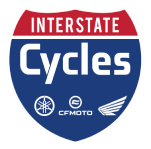The Basics of Motorcycle Brakes
 There’s nothing quite like feeling a powerful motorcycle underneath us, but anything that moves that fast also needs to be able to stop quickly. That’s why your motorcycle needs a good braking system. You need to make safety decisions as though your life depends on it, because it does! Here’s a look at the basics of motorcycle brakes. For more information visit us at Interstate Cycles in Lake City, Florida, serving Jacksonville and Gainesville, Florida.
There’s nothing quite like feeling a powerful motorcycle underneath us, but anything that moves that fast also needs to be able to stop quickly. That’s why your motorcycle needs a good braking system. You need to make safety decisions as though your life depends on it, because it does! Here’s a look at the basics of motorcycle brakes. For more information visit us at Interstate Cycles in Lake City, Florida, serving Jacksonville and Gainesville, Florida.
The Development of Anti Block System (ABS) Brakes
It didn’t take long for early motorcycle builders to realize it wasn’t safe to stop them with their feet. Early braking systems were replaced with drum brakes in the 1920s, and motorcycle brakes remained more or less unchanged until disc brakes became popular in the 1960s. But the big game changer was when BMW’s engineers released the first ABS brakes in 1989. ABS brakes are a computerized safety measure that pulsates brakes to prevent skids and lockouts. Some advanced riders still prefer the ability to lock their wheels on purpose in a controlled skid, but ABS brakes are a popular and effective safety feature enjoyed by riders of all experience levels.
How to Learn Your Braking System
Every bike handles and brakes differently, and you’ll want to get familiar with how yours works as quickly as possible. Most of the braking is done with the front wheel, with the exception of dirt bikes. You’ll need to learn how the weight is distributed in your bike and how that will affect your braking. Cruisers and choppers have their weight more evenly divided from front to back, and rear braking makes more of a difference than it will if you are using a sportsbike or a racing bike.
Your front hand brake is located on the opposite side of your clutch, and you should be able to reach it easily at all times. Familiarize yourself with the responsiveness of both your front and rear brake, and give yourself some time to learn how your ABS brakes handle if you’re using them for the first time.
Safety is No Accident!
It’s always a good idea to find a big empty parking lot and practice braking at higher speeds. If you can find the limits of both your front and back brakes and know how to anticipate a skid it will come in handy on the roads. Your tires have the most grip when your bike is in the upright position and you should always apply your brakes before you enter a turn. Watch out for wet roads, ice and oil as you ride. Most importantly, always be patient with other motorists.
Visit us at Interstate Cycles in Lake City, Florida, serving Jacksonville and Gainesville, Florida, for more information and to see our current inventory of motorcycles for sale.
